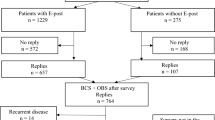Abstract
Background
The effect of lumpectomy defect repair (a level 1 oncoplastic technique) on patient-reported breast satisfaction among patients undergoing lumpectomy has not yet been investigated.
Methods
Patients undergoing lumpectomy at our institution between 2018 and 2020 with or without repair of their lumpectomy defect during index operation, comprised our study population. The BREAST-Q quality-of-life questionnaire was administered preoperatively, and at 6 months, 1 year, and 2 years postoperatively. Satisfaction and quality-of-life domains were compared between those who did and did not have closure of their lumpectomy defect, and compared with surgeon-reported outcomes.
Results
A total of 487 patients met eligibility criteria, 206 (42%) had their partial mastectomy defect repaired by glandular displacement. Median breast volume, as calculated from the mammogram, was smaller in patients undergoing defect closure (826 cm3 vs. 895 cm3, p = 0.006). There were no statistically significant differences in satisfaction with breasts (SABTR), physical well-being of the chest (PWB-CHEST), or psychosocial well-being (PsychWB) scores between the two cohorts at any time point. While patients undergoing defect closure had significantly higher sexual well-being (SexWB) scores compared with no closure (66 vs. 59, p = 0.021), there were no predictors of improvement in SexWB scores over time on multivariable analysis. Patients’ self-reported scores positively correlated with physician-reported outcomes.
Conclusions
Despite a larger lumpectomy-to-breast volume ratio among patients undergoing defect repair, satisfaction was equivalent among those whose defects were or were not repaired at 2 years postsurgery. Defect repair was associated with clinically relevant improvement in patient-reported sexual well-being.


Similar content being viewed by others
References
Fisher B, Anderson S, Bryant J, et al. Twenty-year follow-up of a randomized trial comparing total mastectomy, lumpectomy, and lumpectomy plus irradiation for the treatment of invasive breast cancer. N Engl J Med. 2002;347(16):1233–41.
Early Breast Cancer Trialists’ Collaborative Group. Effects of radiotherapy and surgery in early breast cancer. An overview of the randomized trials. N Engl J Med. 1996;334(15):1003.
Veronesi U, Cascinelli N, Mariani L, et al. Twenty-year follow-up of a randomized study comparing breast-conserving surgery with radical mastectomy for early breast cancer. N Engl J Med. 2002;347(16):1227–32.
Pesce C, Jaffe J, Kuchta K, Yao K, Sisco M. Patient-reported outcomes among women with unilateral breast cancer undergoing breast conservation versus single or double mastectomy. Breast Cancer Res Treat. 2021;185(2):359–69.
Tsai HY, Kuo RN, Chung KP. Quality of life of breast cancer survivors following breast-conserving therapy versus mastectomy: a multicenter study in Taiwan. Jpn J Clin Oncol. 2017;47(10):909–18.
Kaviani A, Sodagari N, Sheikhbahaei S, et al. From radical mastectomy to breast-conserving therapy and oncoplastic breast surgery: a narrative review comparing oncological result, cosmetic outcome, quality of life, and health economy. ISRN Oncol. 2013;2013:742462.
Chand ND, Browne V, Paramanathan N, Peiris LJ, Laws SA, Rainsbury RM. Patient-reported outcomes are better after oncoplastic breast conservation than after mastectomy and autologous reconstruction. Plast Reconstr Surg Glob Open. 2017;5(7):e1419.
Pusic AL, Klassen AF, Scott AM, Klok JA, Cordeiro PG, Cano SJ. Development of a new patient-reported outcome measure for breast surgery: the BREAST-Q. Plast Reconstr Surg. 2009;124(2):345–53.
Cano SJ, Klassen AF, Scott AM, Cordeiro PG, Pusic AL. The BREAST-Q: further validation in independent clinical samples. Plast Reconstr Surg. 2012;129(2):293–302.
Klassen AF, Dominici L, Fuzesi S, et al. Development and validation of the BREAST-Q breast-conserving therapy module. Ann Surg Oncol. 2020;27(7):2238–47.
Voineskos SH, Klassen AF, Cano SJ, Pusic AL, Gibbons CJ. Giving meaning to differences in BREAST-Q scores: minimal important difference for breast reconstruction patients. Plast Reconstr Surg. 2020;145(1):11e–20e.
Volpara TruDensity® System. https://www.volparahealth.com/science/algorithms/density.
Cochrane RA, Valasiadou P, Wilson AR, Al-Ghazal SK, Macmillan RD. Cosmesis and satisfaction after breast-conserving surgery correlates with the percentage of breast volume excised. Br J Surg. 2003;90(12):1505–9.
Q-Portfolio. BREAST-Q version 2.0: A Guide for researchers and clinicians.http://qportfolio.org/wp-content/uploads/2020/02/BREAST-Q-USERS-GUIDE-V2.pdf. Accessed April 20, 2023
Gil-Olarte P, Gil-Olarte MA, Gómez-Molinero R, Guil R. Psychosocial and sexual well-being in breast cancer survivors undergoing immediate breast reconstruction: the mediating role of breast satisfaction. Eur J Cancer Care (Engl). 2022;31(6):3686. https://doi.org/10.1111/ecc.13686.
Hadjittofi C, Almalki H, Mirshekar-Syahkal B, Pain S, Zechmeister K, Hussien M. Simple oncoplastic breast defect closure improves long-term cosmetic outcome of breast conserving surgery for breast cancer: a randomised controlled trial. Breast. 2022;65:104–9.
Acknowledgments
This study was presented in poster format at the 24th Annual Meeting of the American Society of Breast Surgeons, April 26–30, 2023, Boston, MA. We thank Jessica Moore of Memorial Sloan Kettering Cancer Center for provision of editorial support.
Author information
Authors and Affiliations
Corresponding author
Ethics declarations
Disclosures
The preparation of this study was supported in part by NIH/NCI Cancer Center Support Grant P30CA008748 to Memorial Sloan Kettering Cancer Center. Sixth author Dr. Katja Pinker-Domenig has served on speaker bureaus for Bayer, Siemens Healthineers, Olea Medical, and Roche. She also has provided consulting/advisory services for Genentech, Merantix Healthcare, AURA Health Technologies GmbH, and Guerbet. No other authors have relationships with outside entities to disclose.
Additional information
Publisher's Note
Springer Nature remains neutral with regard to jurisdictional claims in published maps and institutional affiliations.
Rights and permissions
Springer Nature or its licensor (e.g. a society or other partner) holds exclusive rights to this article under a publishing agreement with the author(s) or other rightsholder(s); author self-archiving of the accepted manuscript version of this article is solely governed by the terms of such publishing agreement and applicable law.
About this article
Cite this article
Palmquist, E., Sevilimedu, V., Garcia, P. et al. Patient-Reported Outcomes in Patients Undergoing Lumpectomy With and Without Defect Closure. Ann Surg Oncol 31, 1615–1622 (2024). https://doi.org/10.1245/s10434-023-14584-z
Received:
Accepted:
Published:
Issue Date:
DOI: https://doi.org/10.1245/s10434-023-14584-z




